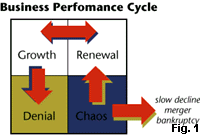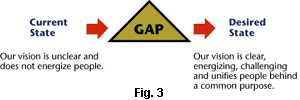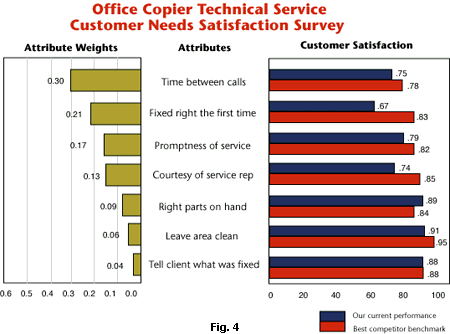|
|
 |
 |
 |
|
 |
|
Check out this hot new concept for the "nanosecond '90s." During the past decade, there have been many successful programs to improve organizational performance. In the 1980s, we implemented problem solving, statistical process control, quality tools and total quality management. We reduced defects and installed just-in-time inventory control, hoshin planning and process improvement. In the early 1990s, the most popular programs were benchmarking, ISO 9000, activity-based costing, time compression and reengineering. Organizations downsized and restructured. We improved productivity, developed innovative products, reduced costs, improved time to market, improved quality and customer satisfaction, reengineered operations and improved shareholder value. And we made sure next-quarter earnings were up. Yet despite all this, much of which was successful, organizations are still feeling pain -- loss of market share, slow growth, low return on assets, declining shareholder value, lagging productivity, sagging employee morale and increasing competition. Is the management revolution that came to be known as the "quality movement" dead? No. In fact, the management revolution is entering a new stage of maturity. Quality has been operationalized into many organizations. What's next? What's hot, what's not The hot new concepts organizations are now discovering include: continual renewal, business self-assessment, balanced scorecard of measures, customer retention and value, leveraged change, rapid response initiatives and strategic alignment. But don't throw away your old programs. You will use them again, only more selectively, to manage and leverage change where you can achieve the highest performance payback. All of these concepts are important components of an overarching system -- called an integrated management system -- that delivers results. The need for an IMS has been evident for some time. In the 1980s, the major challenge facing most organizations was to improve quality. In the early 1990s, it was to improve faster by restructuring and reengineering all operations. The "nanosecond '90s" requires leaders to mobilize all of their organization's resources to continually transform and renew strategies, operations, work culture, structure, people management and development, product development, customer service, mission and values -- before the competition does. The stakes may be survival. An organization that does not, or cannot, continually reinvent and renew itself will sooner or later fall behind the competition (see Figure 1). Xerox in the 1970s, AT&T in the 1980s and, more recently, Kodak and IBM all were market leaders that did not keep pace with industry changes. When an organization starts slipping -- losing market share, experiencing declining customer satisfaction, etc. -- management's first reaction is denial (this can't be happening to us, we're immune, we're No. 1, the competition must be selling below cost, things will settle down and return to normal in a few months). When things don't change, but instead get worse, the reaction turns to panic and chaos (this is serious, why didn't we see it coming, what can we do, let's downsize, drop prices and restructure, or we're dead). |
|
|
 |
 |
 |
 |
|
A new direction: Integrated
Management
Systems |
|
|
|
What An IMS Can Do for Your Organization An IMS provides management with new perspectives on how to: Define goals -- Where are we going? How will we get there? Articulate business strategies -- How do we intend to compete? Implement a "balanced scorecard" of measures -- What must be measured? How much are we improving? Deploy strategies and policies to all organizational levels -- How will we align all tactical actions? Focus improvement efforts on critical business issues -- How will we deploy our resources? Identify and close major performance gaps -- What prevents us from achieving stated goals? Stay focused on customers and other stakeholders -- How will we succeed? Mobilize and energize employees -- What will resolve the most critical issues? Stimulate innovation and creativity. Implement business process management within a structured framework. Identify and focus on high payoff opportunities to improve the business. Deploy "rapid response" teams on a just-in-time basis to find and fix problems quickly. Strive for breakthrough improvements, rather than incremental change. Assign named accountability to all improvement initiatives. Measure results and their impact on the bottom line. |
|
|
|
|
 |
|
|
 |
 |
 |
|
At the point when an organization finds it can no longer compete, continues to lose market share and money, and doesn't know how to reinvent itself, one of several painful options may be all that's left -- slow decline, merger or bankruptcy. The best option, of course, is renewal. Xerox renewed itself as The Document Company. IBM and Kodak are also undergoing changes. Less imaginative organizations succumbed to takeovers or merged to survive. Renewal and growth are what market leaders like Motorola and Hewlett-Packard do continually to sustain their edge and stay ahead of the pack. The good news is that most organizations have the resources and the will to change and renew themselves, but they lack the know-how and tools to do so. Business assessments and an IMS are two of the new essential tools organizations need to make the transition and manage change on a targeted, leveraged and accelerated basis. Combining best practices First of all, an IMS, as the name suggests, isn't one thing. It is a composite of many best practices used by leading-edge organizations. Some of these practices are already in place in many organizations. What's new is how to make them work together. The IMS is a closed-loop management system. All elements are interdependent (hence the bidirectional arrows). Figure 2 illustrates a typical IMS. Here's how it works: |
|
 |
 |
 |
|
 Vision, mission and values -- Organizations begin with a vision (where the organization is going), which is derived from customer needs. A vision is how an organization creates its future and serves as the beacon that provides strategic direction. The vision is translated into a mission (what you do, for whom and why). Vision, mission and values -- Organizations begin with a vision (where the organization is going), which is derived from customer needs. A vision is how an organization creates its future and serves as the beacon that provides strategic direction. The vision is translated into a mission (what you do, for whom and why).
Together, the vision and mission unite people behind a common purpose. Core values provide everyone in the organization with a common framework for making decisions and taking actions (how business will be conducted) that support the organization's vision and strategic goals.  Strategic planning -- Strategic planning follows vision. Strategic planning produces goals and objectives. It converts goals into business strategies, structures, systems, policies and plans that align everyone's efforts behind the vision and strategic goals. Strategic planning determines where you are, where you are going and how you will get there. Strategic planning -- Strategic planning follows vision. Strategic planning produces goals and objectives. It converts goals into business strategies, structures, systems, policies and plans that align everyone's efforts behind the vision and strategic goals. Strategic planning determines where you are, where you are going and how you will get there.
 Business planning -- Management defines financial targets for the organization and sets goals for other issues, ranging from product development, market expansion and environmental goals to productivity targets. Objectives are specific, quantifiable one-year targets. Goals are four- to five-year milestones against which to measure progress. Business planning -- Management defines financial targets for the organization and sets goals for other issues, ranging from product development, market expansion and environmental goals to productivity targets. Objectives are specific, quantifiable one-year targets. Goals are four- to five-year milestones against which to measure progress.
 Customer needs and value -- Success is ultimately determined by how well the organization gives its customers what they want. While virtually all organizations today claim to be customer-focused and customer-driven, a large gap remains between what is professed and what is actually practiced. Management needs to determine how well the organization surveys customer needs, improves customer value, measures customer satisfaction, resolves customer complaints, maintains the customer database, manages customer relationships, retains customers and integrates all of this into the management system. Customer needs and value -- Success is ultimately determined by how well the organization gives its customers what they want. While virtually all organizations today claim to be customer-focused and customer-driven, a large gap remains between what is professed and what is actually practiced. Management needs to determine how well the organization surveys customer needs, improves customer value, measures customer satisfaction, resolves customer complaints, maintains the customer database, manages customer relationships, retains customers and integrates all of this into the management system.
 Business assessments -- At least once a year, it is useful to conduct a business assessment (where the organization is today). One effective approach is to assess the current state of the organization against a set of "desired state" criteria. The assessment can be self-administered or supported by external resources. The assessment should be constructed to correspond with the IMS model. Each element of the model will have a category of survey questions. Each category is divided into areas and items. For example: Business assessments -- At least once a year, it is useful to conduct a business assessment (where the organization is today). One effective approach is to assess the current state of the organization against a set of "desired state" criteria. The assessment can be self-administered or supported by external resources. The assessment should be constructed to correspond with the IMS model. Each element of the model will have a category of survey questions. Each category is divided into areas and items. For example:
1.0 Customer Needs/Value (Category) 1.2 Customer Management (Area) 1.21 Customers have easy access to our organization for assistance, comments and complaints. (Item) Each item on the survey is expressed as a desired state (see Figure 3). Senior managers participating in the survey will rate their organization for every item on the assessment. They use a five-point rating scale based on a scoring guideline that considers the organization's approach (method), deployment (extent to which the method is deployed) and results (performance). Strongly Disagree (1)
Disagree (2)
Neutral (3)
Agree (4)
Strongly Agree (5) Respondents circle the rating (1 - 5) that best corresponds with their assessment of the organization's current state for that item. Differences between a current state (where we are) and desired state (where we want to be) indicate a performance gap (an opportunity for improvement). |
|
 |
 |
 |
 |
 |
|
 |
|
|
The survey data is compiled. All performance gaps are identified, prioritized and put into the business planning process. The business plan states how the organization will achieve its goals, allocate resources and manage operations. A business plan contains several critical elements:  Balanced scorecard -- One of the outcomes of strategic planning is the identification of success criteria -- what the organization must do well to be successful and meet its goals. Success criteria are too often lopsidedly weighted in favor of cost reduction, downsizing and restructuring. A few criteria are aimed at growing the business. The organization needs a balanced scorecard -- a concept popularized by David P. Norton and Robert S. Kaplan. Balanced scorecards usually aim to meet the requirements of all stakeholders -- groups with a stake in the organization's success that must be successful and/or satisfied for the organization to succeed. They typically include customers, shareholders, senior management, employees, suppliers, the community and, in some cases, regulators. Balanced scorecard -- One of the outcomes of strategic planning is the identification of success criteria -- what the organization must do well to be successful and meet its goals. Success criteria are too often lopsidedly weighted in favor of cost reduction, downsizing and restructuring. A few criteria are aimed at growing the business. The organization needs a balanced scorecard -- a concept popularized by David P. Norton and Robert S. Kaplan. Balanced scorecards usually aim to meet the requirements of all stakeholders -- groups with a stake in the organization's success that must be successful and/or satisfied for the organization to succeed. They typically include customers, shareholders, senior management, employees, suppliers, the community and, in some cases, regulators.
 Strategic objectives -- These are what the organization must do to achieve its business goals. Strategic objectives are incorporated into business plans and are continually monitored throughout the year. All strategies should be aligned with the vision and business goals. Strategic objectives -- These are what the organization must do to achieve its business goals. Strategic objectives are incorporated into business plans and are continually monitored throughout the year. All strategies should be aligned with the vision and business goals.
 Critical performance measures and targets -- An IMS requires defining the critical performance measures that drive the business. In addition to the financial measures (ROA, ROE, revenue, etc.), best-practice organizations manage their business day to day by operational measures that predict what will happen. Measures must be directly related to the balanced scorecard. Operational measures might include yield, defect rate, customer satisfaction index, on-time deliveries, process efficiency, employee productivity, supplier effectiveness, sales plan vs. actual, expense projections and other vital data. Critical performance measures and targets -- An IMS requires defining the critical performance measures that drive the business. In addition to the financial measures (ROA, ROE, revenue, etc.), best-practice organizations manage their business day to day by operational measures that predict what will happen. Measures must be directly related to the balanced scorecard. Operational measures might include yield, defect rate, customer satisfaction index, on-time deliveries, process efficiency, employee productivity, supplier effectiveness, sales plan vs. actual, expense projections and other vital data.
Aligning financial and operational measures to the business strategies and success criteria is a must for continued improvement in results. Critical performance measures usually include long-term and short-term goals and objectives. Targets are established using current performance and benchmark data.  Analyze performance drivers and determine business priorities -- With critical performance measures in place, management must determine what drives the measures. Performance drivers are the factors with the biggest impact on moving the business forward (see Figure 4). Analyze performance drivers and determine business priorities -- With critical performance measures in place, management must determine what drives the measures. Performance drivers are the factors with the biggest impact on moving the business forward (see Figure 4).
|
|
|
 |
|
|
In this example, the data shows that to move customer satisfaction, the biggest leverage is to improve time between calls and fixing it right the first time. These two attributes have the highest weights with customers and offer significant opportunities to improve performance. They might become the organization's top business priorities for improving customer satisfaction and value.  Process improvement -- The next step is to identify the processes that most impact each performance driver. In order to achieve quantum performance gains quickly, rapid response teams are appointed and trained on a just-in-time basis. They undertake only the initiatives determined to be critically important to achieving strategic goals. Process improvement -- The next step is to identify the processes that most impact each performance driver. In order to achieve quantum performance gains quickly, rapid response teams are appointed and trained on a just-in-time basis. They undertake only the initiatives determined to be critically important to achieving strategic goals.
 Management review -- To close the loop, management reviews all predictive measures and results, assesses progress of all key improvement initiatives, makes sure that all targets were achieved, analyzes shortfalls and takes immediate corrective action. The management review process examines the organization's financial performance, customer satisfaction, employee satisfaction, product and service quality, operational efficiency, supplier compliance, productivity gains, return on assets, market share and any other performance measure important to management. They review performance at each organizational level at appropriate intervals. Management review -- To close the loop, management reviews all predictive measures and results, assesses progress of all key improvement initiatives, makes sure that all targets were achieved, analyzes shortfalls and takes immediate corrective action. The management review process examines the organization's financial performance, customer satisfaction, employee satisfaction, product and service quality, operational efficiency, supplier compliance, productivity gains, return on assets, market share and any other performance measure important to management. They review performance at each organizational level at appropriate intervals.
Results are rolled up and linked to the critical performance measures. In addition, the full assessment discussed earlier is repeated once a year to evaluate change and to identify new opportunities for improvement. Key enablers Two key enablers will accelerate improved results from the IMS. They are leadership and human resource development.  Leadership and change management -- People in leadership positions -- senior, middle, first-level and individual contributors -- must use leadership skills to achieve the vision by mobilizing people to achieve objectives, deploy strategies, share authority and responsibility, build trust and credibility, model the way, communicate information, encourage collaboration and support innovation and continuous learning. Leadership and change management -- People in leadership positions -- senior, middle, first-level and individual contributors -- must use leadership skills to achieve the vision by mobilizing people to achieve objectives, deploy strategies, share authority and responsibility, build trust and credibility, model the way, communicate information, encourage collaboration and support innovation and continuous learning.
 Human resource management and development -- Few things have higher priority in managing transformational change than retaining key people and developing people for the future. A system to measure employee satisfaction and listen to the "voice of the employee" is another critical element in the IMS. Human resource management and development -- Few things have higher priority in managing transformational change than retaining key people and developing people for the future. A system to measure employee satisfaction and listen to the "voice of the employee" is another critical element in the IMS.
By analyzing the key drivers of motivation and employee satisfaction (e.g., the opportunity to make a difference, competitive compensation, career advancement, training and development, performance feedback, recognition and rewards), the organization can develop a human resources master improvement plan. This plan summarizes improvement initiatives to be undertaken this year and describes how management will support each area of the business for the next plan period. What IMS accomplishes An IMS, coupled with an annual assessment, provides a cohesive system for defining where the organization is going, determining how it will get there and how fast. Are you ready for IMS? If you think you aren't, consider this:  The breathtaking pace of change today leaves you with little choice but to radically change the way you think and act. The breathtaking pace of change today leaves you with little choice but to radically change the way you think and act.
 Downsizing as a survival strategy has reached the breaking point. The only long-term solution is to grow and renew the business. Downsizing as a survival strategy has reached the breaking point. The only long-term solution is to grow and renew the business.
 Competition is going to get more intense, not less. Competition is going to get more intense, not less.
 Pressure to improve shareholder value will continue. The challenge is to get better, faster. Pressure to improve shareholder value will continue. The challenge is to get better, faster.
Not only that, to compete today, an organization must be good at everything -- speed, cost control, quality, product development and customer service. Being good at one thing, and so-so at the rest, isn't good enough. The name of the game is customer value. Customers will accept no less today. IMS improves operational and financial performance by linking strategy, operational plans and a system of measurements with high-priority change initiatives that continuously drive business results. In other words, IMS provides a systematic, disciplined way to achieve an organization's vision by pursuing prioritized tactical actions. In reality, the path to a vision and strategic goals is seldom a straight line. There are some zigs and zags as organizations make mid-course corrections. IMS eliminates a lot of false starts and keeps everyone in the organization focused on the vision and goals. It mobilizes everyone to work toward the vision, so that results don't fall short of goals. About the authors Ken Breen, a senior partner in The Abbey Group, has extensive experience in developing organizational visions, deploying culture change and facilitating business process improvement initiatives. Gerry Pecora, a senior partner in The Abbey Group, has more than 32 years' experience in managing quality, process improvement and profit strategy, and integrating quality strategies into business plans. Dave Gregerson, a senior partner in The Abbey Group, former vice president of Carrier Corp. (a division of United Technologies) and manager of product development at Ford Motor Co., has extensive experience in all aspects of customer satisfaction, new product introduction and product quality assurance, supplier relationships, process control and business process improvement. Tom McCabe, an associate of The Abbey Group and CEO of PaceWare Systems, a courseware development company, has more than 30 years' experience designing instructional programs in sales, management, process improvement, quality control and benchmarking methods. For more information or examples of how organizations have deployed an IMS, contact the authors at: The Abbey Group, 29 Silver Spring Road, Ridgefield, CT 06877, telephone (203) 431-4057, fax (203) 431-4504. |
|
|








 Vision, mission and values -- Organizations begin with a vision (where the organization is going), which is derived from customer needs. A vision is how an organization creates its future and serves as the beacon that provides strategic direction. The vision is translated into a mission (what you do, for whom and why).
Vision, mission and values -- Organizations begin with a vision (where the organization is going), which is derived from customer needs. A vision is how an organization creates its future and serves as the beacon that provides strategic direction. The vision is translated into a mission (what you do, for whom and why).